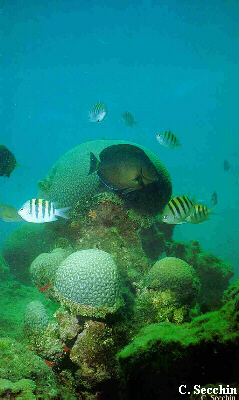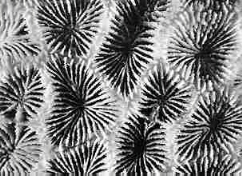| Mussismilia braziliensis forms massive, globular
colonies, that may be hemispheric, and that are
fixed strongly to the substrate. They can reach
diameters of more than 1 m. The calices are
polygonal and relatively small (8 to 10 mm in
diameter). The central column is reduced, the septa
are delicate and the fourth cycle is incomplete. In
the large colonies a tendency to form roughly
elongated submeandroid calices with more than
three columnar centers has been observed. The
color of the live colony varies between whitish gray
and whitish yellow. Mussismilia braziliensis is endemic to Brazil. It
has archaic characteristics, similar to those species
from the Miocene Mediterranean basin. Together
with Favia leptophylla, it shows the greatest
geographic confinement; it is registered only along
the coast of Bahia state. It is the principal
constructor of the tops and edges of reefs in the
|  |
 | Abrolhos region. On the reefs of Itaparica island
roughly hemispheric forms, measuring 5 to 10 cm
in diameter, are found in the pools and channels of
the reef structure. On the reef front, in waters of
depths around 5 m, larger, dome like, colonies
occur (maximum diameter 0.5 m). On the reefs of
the northern coast of the state of Bahia, this
species occurs at depths of 4 to 10 m. |

